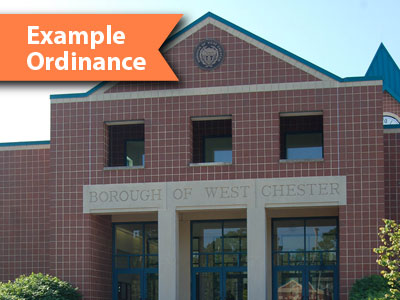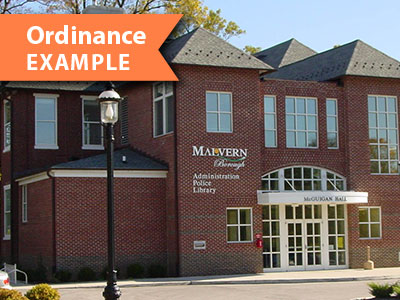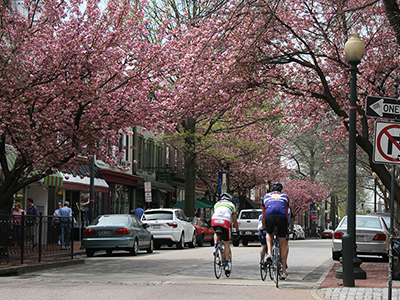Street trees can also be located in front yards rather than between the roadway and the sidewalk. Although growing conditions might be better for trees, homeowners also may have more ability to remove trees if they choose.
How it Works
Street trees are an integral component of the urban environment and provide ecological, social, economic, and aesthetic benefits to communities. Municipalities can encourage a healthy network of street trees by regulating the species, location, ownership, maintenance practices, and replacement standards for street trees through a street tree ordinance or provisions in a subdivision and land development ordinance. A public awareness program concerning the importance of street trees also contributes to the overall health and longevity of the trees.
Some municipalities choose to manage the maintenance of street trees within the public right-of-way, while others place the responsibility on the abutting property owner. These different ownership structures require different ordinances and planning documents to have a successful urban forest management program. Some municipalities may have both ownership structures where homeowners maintain street trees on private roads and within parking lots, and the municipality maintains trees along public streets.
Municipalities can establish shade tree commissions, a volunteer committee that manages the care of shade trees within the public realm.
Street trees are subject to harsh environmental conditions and can impact surrounding infrastructure if an inappropriate tree species was selected or if not properly maintained. Selecting a tree species that is appropriate for the conditions is of critical importance for the longevity of the tree.
Mature flowering cherry trees in West Chester Borough add beauty and pedestrian scale to the streetscape and provide shade.

Street trees along Bridge Street in Phoenixville Borough provide shade and add to the borough's sense of place.
Benefits
Shade and Cooling Effect
Through their shade and evapotranspiration, street trees create cooler microclimates in urban areas, reducing the urban heat island effect caused by paved surfaces and structures. This can have positive impacts on human health, especially in areas with populations vulnerable to extreme heat.
Stormwater Management
Street trees planted within sidewalks, parking islands, and other impervious areas absorb stormwater and excess nutrients carried therein, reducing runoff that impacts water quality and causes flooding.
Public Health
Recent research finds that having more street trees on a block lowers residents' risk for heart attack and stroke, and is associated with a lower risk of asthma in children and premature mortality.
Increased Property Values
Many studies have shown that street trees in front of homes — particularly mature street trees — increase a home's value significantly, which generates value for homeowners, municipalities and school districts.
Community Identity and Beauty
Healthy street trees help create a sense of place and their variations in color, texture, and form are aesthetically pleasing.
Reduction of Impacts on Properties from the Built Environment
Street trees reduce the impact of the built environment on homes and businesses, reducing noise, dust, and light glare while also improving privacy and screening unsightly properties.
London plane trees along the streets in a housing development in South Coventry Township provide shade, reduce building energy costs, and create an attractive streetscape.
Get Started
The requirement for street trees within new development is typically found within the subdivision and land development ordinance or a stand-alone street tree ordinance. Street trees are often required every certain number of feet (e.g., 30' or 40' on-center), and the code may refer to a recommended street tree list. Plant lists included within municipal ordinances should specify which trees are recommended as street trees, as they must be well-suited to roadside conditions including the presence of overhead utilities, where applicable.
Stand-alone street tree ordinances govern the selection, planting, maintenance, ownership, and replacement of street trees. This can help provide consistent guidance to property owners responsible for taking care of street trees to ensure the overall health of the urban forest and suburban neighborhoods.
For municipalities that have ownership over street trees, it may be helpful to have a community forestry or tree canopy management plan. This document can contain an inventory of trees, maintenance regime, parties responsible for maintenance, programmatic elements of tree care such as volunteer programs and tree tagging, and plant lists. Additionally, it can establish overall tree canopy goals, identify specific locations where additional trees are needed, and lay out a plan for how to meet those goals.
To develop and maintain an inventory of street trees and their maintenance needs, some municipalities appoint shade tree commissions. These commissions are established by ordinance and members are typically involved in all aspects of tree selection, planting, maintenance, and replacement. A municipality may also choose to consult with a professional arborist to advise on street tree related issues and to conduct planting, maintenance, and replacement as needed.
Mature hawthorn trees planted under power lines in West Chester Borough. Planting shorter tree species like this example under power lines reduces the need for heavy pruning (or tree removal) as the tree grows.
Considerations
Maintenance
Municipalities should consider whether abutting landowners or the municipality is responsible for maintenance of street trees. A tree ordinance can specify maintenance responsibility and provide specifications for regular inspection, pruning, and tree replacement.
Public Education
Residents should receive information regarding the advantages and proper maintenance of street trees to better appreciate their benefits and to be stewards of any street trees for which they are responsible.
Right Plant, Right Place
Urban conditions, especially the areas between a paved road and sidewalk, are harsh growing conditions for trees. Street trees in particular are regularly subject to road salt and vehicle damage and have limited area for roots to spread. Some trees naturally shed their lower branches, drop fruit or nuts, which can cause damage to vehicles and cause tripping hazards on sidewalks. These challenges can be mitigated by selecting an appropriate tree species. A landscape architect or arborist should be consulted about tree selection in the public realm, and the municipality should generate a list of street trees that are appropriate for the specific conditions of their community.
Climate Change
Due to climate change, some trees species that are considered native no longer thrive in our climate, particularly in harsh urban environments. Municipalities should consult with an arborist on tree selection and refer to plant lists that take the changing climate into consideration.
Avoid Monocultures
Avoid planting a single species to encourage biodiversity and avoid decimation of all trees in the case of a disease that attacks certain species. Trees such as non-blight resistant American elms and ash trees should be avoided due to the prevalence of disease.
Street Tree Infrastructure
Tree pits, or the common 4'x4' planting area street trees are planted within, are sometimes referred to as "tree coffins" given how little space, water, and nutrients they provide. For this reason, many urban trees have a relatively short life span and don't grow to their full mature size. Better subsurface systems, such as structural soil and/or modular soil cell systems, provide tree roots more room and healthier conditions in which to grow.

The West Chester Borough Tree Ordinance acknowledges the public benefit of trees and creates regulations that aim to preserve, protect, and restore the health of existing trees within the Borough and to promote the planting of new trees.
The borough's complete list of approved street trees provides many options for street trees, though some municipalities may wish to permit only native species.

The Malvern Borough Shade Tree Commission oversees selection, planting, maintenance, and removal/replacement of all street trees. Several Chester County municipalities have volunteer shade tree commissions to oversee the shade trees within the public realm.

The West Whiteland Township Street Tree Requirements and standards for parking lot landscaping from the township's Subdivision and Land Development Ordinance provide good standards for suburban municipalities.
The township's recommended plant species list includes street trees.

For more tree ordinance examples and information on shade tree commissions, see the Urban Trees and Shade Tree Commission sections of the Chester County Planning Commission's webpage Planting and Maintaining New Trees.






